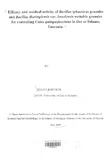| dc.contributor.author | Ndaro, Johnson | |
| dc.date.accessioned | 2016-05-23T15:07:04Z | |
| dc.date.available | 2016-05-23T15:07:04Z | |
| dc.date.issued | 2009 | |
| dc.identifier.uri | http://hdl.handle.net/11295/95889 | |
| dc.description.abstract | The microbial larvicides Bacillus sphaericus and Bacillus thuringiensis have recently proven to be effective tools for integrated mosquito control programmes in Africa. This study assessed the efficacy and duration of activity of Bs and Bti for controlling Culex quinquefasciatus Say in the pit latrines and cesspits of urban Dar es Salaam, Tanzania. Larval sampling was conducted on a weekly basis for six weeks prior to treatment and sixteen weeks post treatment in both habitats categories. Three different dosages (low, medium and high) of Bs and Bti were randomly assigned to 70 of each habitat type following stratification within pit latrine and cesspit categories according to larval density, while ten of each habitats type served as controls. Bti at all doses of application achieved very short-lived and weak levels of control of immature stage of Culex in both habitats types. The medium and high doses of Bs achieved complete control of Cx quinquefasciatus late-stage larvae for approximately five weeks in pit latrines while the low dose provided only one week of complete control. In contrast, all three doses of Bs achieved complete control of late-stage larvae for only one week in cesspits. Using a minimum threshold of 80% control, as the criterion for acceptable operational control, Bti at all doses did not achieved acceptable partial control for any extended period in pit latrines and cesspits. The low dose of Bs in pit latrines provided six weeks of acceptable partial control of late-stage larvae while the medium and high dose achieved twelve and eight weeks of partial control, respectively. For both low, medium and high doses of Bs in cesspits attained partial control of late-stage larvae of not more than six weeks. The extended control provided by Bs therefore great advantages to any control programme, such as the Dar es Salaam Urban Malaria Control Programme, that could correspondingly reduce the cost of product procurement and of application and monitoring which are often higher than the cost of material in operational programmes. | en_US |
| dc.language.iso | en | en_US |
| dc.publisher | University of Nairobi | en_US |
| dc.rights | Attribution-NonCommercial-NoDerivs 3.0 United States | * |
| dc.rights.uri | http://creativecommons.org/licenses/by-nc-nd/3.0/us/ | * |
| dc.title | Bacillus sphaericus granules, Bacillus thuringiensi, thuringiensis var. israelensis, wettable granules,Culex quinquefasciatus,Dar es Salaam,Tanzania | en_US |
| dc.type | Thesis | en_US |



